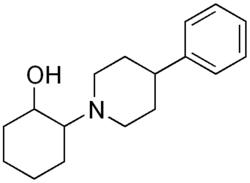Chemistry:Vesamicol
 | |
| Legal status | |
|---|---|
| Legal status |
|
| Identifiers | |
| |
| CAS Number | |
| PubChem CID | |
| IUPHAR/BPS | |
| ChemSpider | |
| UNII | |
| ChEMBL | |
| Chemical and physical data | |
| Formula | C17H25NO |
| Molar mass | 259.393 g·mol−1 |
| 3D model (JSmol) | |
| |
Vesamicol is an experimental drug, acting presynaptically by inhibiting acetylcholine (ACh) uptake into synaptic vesicles and reducing its release.[1] Vesamicol may have applications for the treatment of adenocarcinoma in situ of the lung.[2]
Mechanism of action
Vesamicol can be broadly categorized as a cholinergic physiological antagonist, because it reduces the apparent activity of cholinergic neurons, but does not act at the postsynaptic ACh receptor. Vesamicol causes a non-competitive and reversible block of the intracellular transporter VAChT responsible for carrying newly synthesized ACh into secretory vesicles in the presynaptic nerve terminal. This transport process is driven by a proton gradient between cell organelles and the cytoplasm. Blocking of acetylcholine loading leads to empty vesicles fusing with neuron membranes, decreasing ACh release.[3]
References
- ↑ "Vesamicol, an acetylcholine uptake blocker in presynaptic vesicles, suppresses rapid eye movement (REM) sleep in the rat". Psychopharmacology 121 (4): 485–7. October 1995. doi:10.1007/BF02246498. PMID 8619013.
- ↑ "Inhibition of cholinergic signaling causes apoptosis in human bronchioalveolar carcinoma". Cancer Research 73 (4): 1328–39. February 2013. doi:10.1158/0008-5472.CAN-12-3190. PMID 23222296. PMC 10461321. http://cancerres.aacrjournals.org/content/early/2012/12/06/0008-5472.CAN-12-3190.full.pdf.
- ↑ "Release of Neurotransmitters" (in en). From Molecules to Networks - An Introduction to Cellular and Molecular Neuroscience\ (3rd ed.). Academic Press. 2014. pp. 443–488. doi:10.1016/B978-0-12-397179-1.00015-4. ISBN 978-0-12-397179-1.
 |

